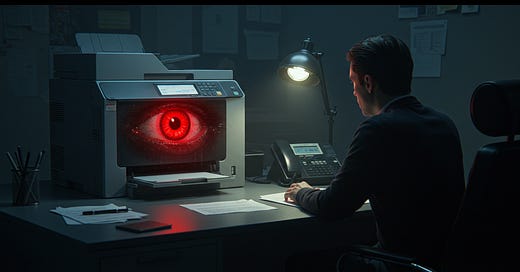Your Printer is Spying on You – Here’s How to Stop It
Think Your Printer is Just a Printer? Think Again
Imagine printing an anonymous whistleblower document, a leaked memo, or even just a personal letter. You hand it off, believing it’s completely untraceable—only to find out later that your printer secretly embedded a hidden code on the page that could lead straight back to you.
This isn’t a conspiracy theory. It’s a real, documented surveillance technique that has existed for decades.
Why Should You Care?
Most people don’t think of their printer as a security risk, but nearly all modern color laser printers include a hidden tracking system designed to identify the device that printed a document. Governments and law enforcement agencies use this feature to track down the source of printed materials. While it may have been intended for catching counterfeiters, the implications go far beyond that.
Privacy concerns – These dots can be used to trace the source of a document.
Whistleblower protection – Journalists and activists may need to protect document origins.
Awareness – Knowing if your printer uses tracking dots helps you take appropriate countermeasures.
Journalists, activists, and even ordinary citizens have been caught off guard by this hidden surveillance tool. In 2017, the NSA contractor Reality Winner was arrested after printing and leaking classified documents—partially because investigators were able to trace the document back to the exact printer used.
How Does Printer Tracking Work?
This method relies on tiny, almost invisible yellow dots, known as machine identification codes, that printers embed onto every printed page.
These dots encode:
The printer’s serial number
The date and time of printing
Other identifying information unique to your device
These dots are invisible to the naked eye but can be revealed using a blue LED light or by adjusting the contrast in an image editing program.
Governments, corporations, and law enforcement agencies can use these codes to trace documents back to specific individuals or organizations. And since most people don’t even know this exists, they’re completely unaware of the privacy risks.
How to Protect Yourself
If you want to avoid this type of tracking, here’s what you can do:
Use an Inkjet Printer – Most inkjet printers don’t include these tracking dots. If anonymity is important to you, consider switching from a laser printer to an inkjet model.
Check If Your Printer Uses Tracking Dots – Websites like the Electronic Frontier Foundation (EFF) maintain lists of printers known to embed tracking dots.
Disable Tracking (If Possible) – Some high-end printers may allow you to disable this feature through settings or firmware modifications, but this varies by manufacturer.
Print in Black and White – The tracking dots are primarily embedded in color prints, so printing in black and white may reduce the risk (though not eliminate it entirely).
Use Alternative Printing Methods – If you need complete anonymity, consider printing from a public location where there’s no personal link to the printer, such as a library or print shop.
Take Control of Your Privacy
Most people think of cybersecurity in terms of digital threats—hacked accounts, phishing emails, or spyware. But sometimes, the biggest privacy risks come from the least expected sources.
Your printer shouldn’t be a surveillance tool. Take control of your privacy today by checking if your printer tracks you and adopting safer printing habits. Because in a world where everything leaves a digital footprint, even paper isn’t safe.
Get your free personal cybersecurity assessment here
Stay secure, stay confident—CyberLife Coach is here to guide you every step of the way!





Interesting read. I was unaware of this